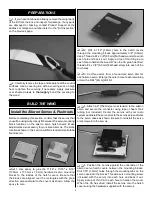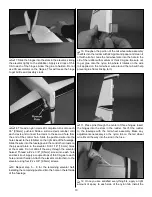
21
Balance Propellers
Carefully balance your propeller and spare propellers
before you fl y. An unbalanced prop can be the single
most signifi cant cause of vibration that can damage your
model. Not only will engine mounting screws and bolts
loosen, possibly with disastrous effect, but vibration may
also damage your radio receiver and battery. Vibration can
also cause your fuel to foam, which will, in turn, cause your
engine to run hot or quit.
We use a Top Flite Precision Magnetic Prop Balancer
(TOPQ5700) in the workshop and keep a Great Planes
Fingertip Prop Balancer (GPMQ5000) in our fl ight box.
Ground Check
If the engine is new, follow the engine manufacturer’s
instructions to break-in the engine. After break-in,
confi rm that the engine idles reliably, transitions smoothly
and rapidly to full power and maintains full power—
indefi nitely. After you run the engine on the model, inspect
the model closely to make sure all screws remained tight,
the hinges are secure, the prop is secure and all pushrods
and connectors are secure.
Range Check
Ground check the operational range of your radio before the
fi rst fl ight of the day. With the transmitter antenna collapsed
and the receiver and transmitter on, you should be able to
walk at least 100 feet [30m] away from the model and still
have control. Have an assistant stand by your model and,
while you work the controls, tell you what the control surfaces
are doing. Repeat this test with the engine running at
various speeds with an assistant holding the model, using
hand signals to show you what is happening. If the control
surfaces do not respond correctly, do not fl y! Find and
correct the problem fi rst. Look for loose servo connections
or broken wires, corroded wires on old servo connectors,
poor solder joints in your battery pack or a defective cell, or
a damaged receiver crystal from a previous crash.
ENGINE SAFETY PRECAUTIONS
Failure to follow these safety precautions may result in
severe injury to yourself and others.
●
Keep all engine fuel in a safe place, away from high
heat, sparks or fl ames, as fuel is very fl ammable. Do
not smoke near the engine or fuel; and remember that
engine exhaust gives off a great deal of deadly carbon
monoxide. Therefore do not run the engine in a closed
room or garage.
●
Get help from an experienced pilot when learning to
operate engines.
●
Use safety glasses when starting or running engines.
●
Do not run the engine in an area of loose gravel or
sand; the propeller may throw such material in your
face or eyes.
●
Keep your face and body as well as all spectators away
from the plane of rotation of the propeller as you start
and run the engine.
●
Keep these items away from the prop: loose clothing,
shirt sleeves, ties, scarves, long hair or loose objects
such as pencils or screwdrivers that may fall out of shirt
or jacket pockets into the prop.
●
Use a “chicken stick” or electric starter to start the
engine. Do not use your fi ngers to fl ip the propeller.
Make certain the glow plug clip or connector is secure
so that it will not pop off or otherwise get into the
running propeller.
●
Make all engine adjustments from behind the rotating
propeller.
●
The engine gets hot! Do not touch it during or right after
operation. Make sure fuel lines are in good condition so
fuel will not leak onto a hot engine, causing a fi re.
●
To stop a glow engine, cut off the fuel supply by closing
off the fuel line or following the engine manufacturer’s
recommendations. Do not use hands, fi ngers or any
other body part to try to stop the engine. To stop a
gasoline powered engine an on/off switch should be
connected to the engine coil. Do not throw anything into
the propeller of a running engine.
LITHIUM BATTERY
HANDLING & USAGE
WARNING!! Read the entire instruction sheet included with
the battery. Failure to follow all instructions could cause
permanent damage to the battery and its surroundings, and
cause bodily harm!
●
ONLY use a LiPo approved charger. NEVER use a
NiCd/NiMH peak charger!
●
NEVER charge in excess of 4.20V per cell.
●
ONLY charge through the “charge” lead. NEVER
charge through the “discharge” lead.
●
NEVER charge at currents greater than 1C.
●
ALWAYS set charger’s output volts to match battery
volts.
●
ALWAYS charge in a fi reproof location.
●
NEVER trickle charge.
●
NEVER allow battery temperature to exceed 150° F
(65° C).
●
NEVER disassemble or modify pack wiring in any way
or puncture cells.
●
NEVER discharge below 2.5V per cell.
●
NEVER place on combustible materials or leave
unattended during charge or discharge.
●
ALWAYS KEEP OUT OF REACH OF CHILDREN.




































